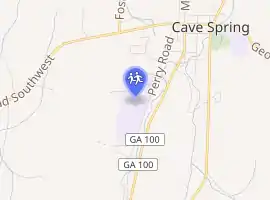Georgia School for the Deaf
Georgia School for the Deaf (GSD) is a public residential school for the deaf. GSD provides comprehensive education and services to deaf and hard-of-hearing students between the ages of three and twenty-two. Located in Cave Spring, Georgia, United States, the school offers day and residential programs which meet the academic, social and physical needs of students in a bilingual (American Sign Language and English) environment.[1][2] It was established in 1846 and is one of three public state schools operated by the Georgia Department of Education.[3]
| Georgia School for the Deaf | |
|---|---|
 | |
| Address | |

| |
232 Perry Farm Road SW , 30124 United States | |
| Information | |
| Type | School for the deaf, state school |
| Established | 1846 |
| Director | Kenney Moore |
| Principal | Lesile Jackson |
| Grades | PK-12 |
| Enrollment | Approx. 75 students (2020) |
| Color(s) | Green and gold |
| Mascot | Tiger |
| Team name | Tigers |
| Languages | American Sign Language, English |
| Website | www |

History
Located in Northwest Georgia near Rome, Georgia School for the Deaf is in the scenic Vann's Valley. It is Georgia's only residential school serving Deaf and Hard-of-Hearing students. GSD was established in 1846 on the grounds of the Hearn Academy by one of its teachers, O. P. Fannin. A log cabin, a $5000 legislative grant, and four students[4] began a more than 170-years-long tradition of service to children across the state. GSD was the eleventh residential school for the deaf established in the United States.[5]
Campus
GSD has an extensive campus of almost 500 acres (2.0 km2) in the small community of Cave Spring. The relationship between Cave Spring and GSD is one-of-a-kind because many residents and business owners are able to communicate with American Sign Language.[6] GSD is currently based on the Perry Farm, just outside of Cave Spring, but was originally located in Downtown Cave Spring in what is now the Cave Spring City Hall.
Mission statement
All GSD students will graduate with a positive Deaf identity as bilinguals in American Sign Language and English and will be prepared to make successful life choices.[6]
Vision
"The Georgia School for the Deaf offers high quality educational and extracurricular activities that prepare its graduates for further academic, social, and career success. This is achieved in a fully-accessible American Sign Language (ASL)/English bilingual environment, which recognizes ASL users as a distinct cultural and linguistic group. This fosters a positive self-acceptance and self-esteem, affording each student the ability to effectively navigate the world they encounter beyond their K-12 experience. As part of this lifelong learning philosophy, all staff and students consistently strive to improve their use of both ASL and written English."[6]
Residential students
GSD's residential program allows students to access and experience Deaf culture, a unique cultural and linguistic identity. They create long-lasting friendships, develop appropriate social skills, and can be involved in sports and after-school activities.
Students are transported to their homes every weekend.[6]
Athletics
Georgia School for the Deaf has a varsity basketball team for girls and boys, a football team, a soccer team, and a volleyball team.
The female and male varsity basketball teams at GSD compete in the Mason-Dixon Tournament yearly.[7] In 2008 the GSD Lady Tigers won the Mason-Dixon Tournament; it was their first win since 1980.[8]
The GSD football team competes against deaf and hearing schools. They use their hearing disadvantage to their benefit by using sign language in their huddles and mental rhythmic plays.[9]
Athletes
Willie Brown played basketball at GSD. In his sophomore year he was 6'6" and averaged 28 points, 12 rebounds a game. He was voted the number one high school player in northwest Georgia.[10] Brown holds the school record of 2,016 points over four years in basketball at GSD. After graduating, he pursued college basketball at Hofstra University in New York, where he played alongside hearing teammates.[11]
Requirements
To be eligible for admission at GSD, students must be between the ages of 3 and 21 and have an audio-metric hearing loss of 55 dB or greater in the better ear. To live on campus, students must be between the ages of 4 and 21. Students under the age of 4 are eligible for day school admission.[12]
References
- Georgia School for the Deaf http://www.gsdweb.org. Retrieved 31 August 2020. Missing or empty
|title=(help) - "State Schools". Georgia Department of Education. Archived from the original on 2009-03-26. Retrieved 2009-09-17.
- "GA Department of Education". Georgia Department of Education. Retrieved 31 August 2020.
- "Georgia Deaf History". Epeachy News. Archived from the original on May 19, 2009.CS1 maint: unfit URL (link)
- Gannon, Jack (1981). Deaf Heritage – A Narrative History of Deaf America (PDF). Silver Spring, MD: National Association of the Deaf. p. 26. Archived from the original (PDF) on 2012-03-28. Retrieved 2011-09-05.
- "Index". Georgia School for the Deaf.
- "Teams". Georgia School for the Deaf. 2010. Retrieved September 2, 2010.
- "GSD Girls Go on to Win Tournament". www.prepgameface.com. 2008. Retrieved September 9, 2010.
- Letwin, Bill (November 20, 1943). "Deaf Grid Team Wins No.6 on Sign Language". The Milwaukee Journal. pp. 3–4.
- Rogers, Thomas (July 26, 1982). "Sports World Specials; Glenns Devotion". New York Times. pp. 0–1.
- "Deaf Basketball Player: Hofsta's Willie Brown Has Plenty of Heart". Los Angeles Times. January 6, 1985. pp. 1–2.
- "Admissions". Georgia School for the Deaf. 2010. Retrieved September 10, 2010.
External links
- Official website
- Trulia entry for GSD
- Georgia School for the Deaf historical marker